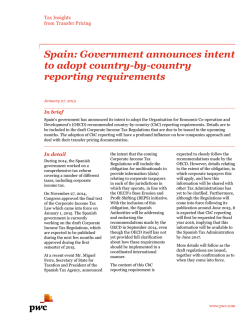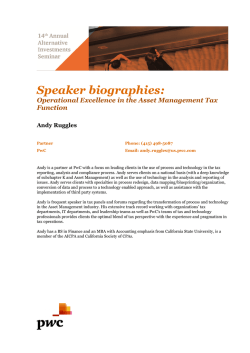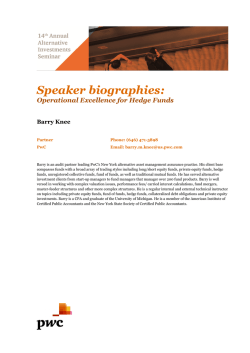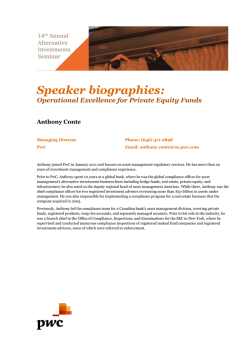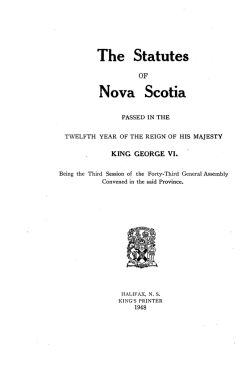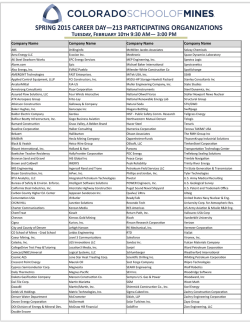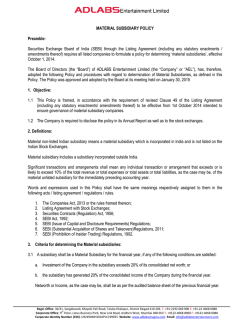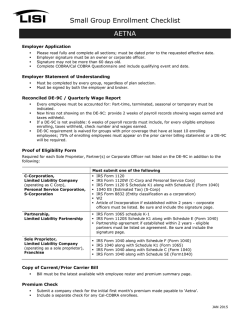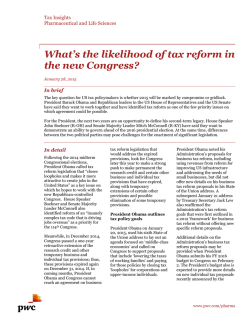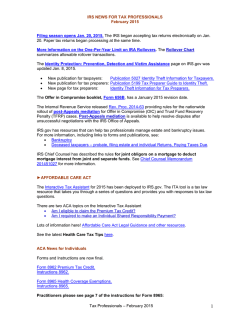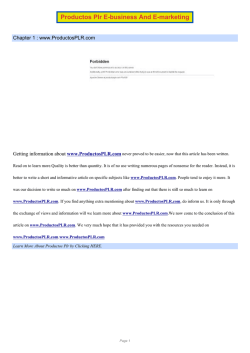
Download PDF
This Month in M&A / Issue 1 / January 2015 Did you know…? p2 / Private letter rulings p5 / Legislative Update p8 M&A tax recent guidance This month features: Intercompany transaction ruled not to require COFL or CSLL recapture (PLR 201452002) IRS analyzes application of Section 382 small redemption exception to certain stock buyback plans (PLR 201451015) Professional corporations ruled to be part of an affiliated group (PLR 201451009) IRS applies Section 332 to corporate conversion to LLC despite asset reincorporation (PLR 201452016) Research credit, other expired provisions extended through 2014 www.pwc.com Did You Know…? A recently released Private Letter Ruling (PLR 201452002) did not require recapture of consolidated overall foreign loss (COFL) or consolidated separate loss limitation (CSLL) accounts in a consolidated group as a result of certain intercompany transactions undertaken as part of a global restructuring. However, cautions remain for taxpayers planning similar restructuring transactions. Background OFL accounts An overall foreign loss (OFL) arises for a tax year when the taxpayer’s aggregate foreign losses exceed its aggregate foreign income. If an OFL offsets domestic income in a given year, the amount of the offset is added to the taxpayer's OFL account and is subject to recapture in a later year. In general, a taxpayer's OFL account is recaptured—meaning foreign income is treated as domestic income—in each succeeding year to the extent of the lesser of the OFL account balance or 50 percent of the taxpayer's foreign income. The OFL account also may be recaptured if a taxpayer disposes of (i) appreciated business assets used predominantly outside the United States or (ii) any share of stock in a controlled foreign corporation (CFC) if the taxpayer owns more than 50 percent of the CFC's stock (the Disposition Rule). COFL accounts A consolidated group must maintain a COFL account. The rules for recapturing a COFL account generally are the same as the rules for recaturing an OFL account, except that the Disposition Rule does not apply at the time of a disposition if the disposition is an intercompany transaction under Reg. sec. 1.1502-13. Instead, in that case, the Disposition Rule applies when, and if, the group is required under Reg. sec. 1.1502-13 to take into account any intercompany items resulting from the disposition. When a member of a consolidated group ceases to be a member, the group apportions a part of its COFL account to the departing member. The amount apportioned is based on the departing member's share of the group's assets that generate income subject to recapture. Facts in the PLR Beginning structure FPS, a Country B entity treated as a partnership for US federal income tax purposes, held certain ownership interests in Foreign Parent, a Country A entity treated as a corporation for US federal income tax purposes. Public investors owned the remaining interests in Foreign Parent. Foreign Parent owned indirectly certain ownership interests in FSub1, a Country B entity treated as a corporation for US federal income tax purposes. FSub1 owned certain ownership interests in FDRE1, a Country A entity that was disregarded for US federal income tax purposes. FDRE1 owned certain ownership interests in Parent, a US corporation. Parent was the common parent of an affiliated group of corporations that joins in filing a consolidated 2 PwC US federal income tax return (the Parent Group). FDRE1 also heldcertain ownership interests in FSub2, a Country A entity treated as a corporation for US federal income tax purposes. FSub2 heldcertain ownership interests in certain foreign entities organized in various jurisdictions (collectively, the FDRE1 Foreign Entities). The FDRE1 Foreign Entities were not CFCs. Parent owned indirectly certain ownership interests in Sub1, a US corporation that is a member of the Parent Group. Sub1 held certain ownership interests in DRE1, a US limited liability company (LLC) that was disregarded as an entity for US federal income tax purposes. DRE1 owned certain ownership interests in Sub2, a State B corporation that was a member of the Parent Group. DRE1 also held certain ownership interests in FDRE2, a Country A disregarded entity. FDRE2 held certain ownership interests in FSub3, a Country A entity treated as a corporation for US federal income tax purposes. FSub3 owned, directly and indirectly, certain ownership interests in certain foreign entities organized in various jurisdictions (collectively, the Parent Group Foreign Entities), most of which were disregarded entities. FSub3 and the Parent Group Foreign Entities (collectively, the Parent Group Foreign Corporate Entities) were treated as corporations for US federal income tax purposes and were CFCs. (See Diagram 1 below.) Diagram 1 The Parent Group had COFL and CSLL accounts, as well as an overall domestic loss (ODL) account. All foreign income, loss, tax attributes, and the COFL and CSLL accounts were (and were expected to continue being) in the Section 904(d) general basket, except for the small ODL in the passive basket. Transaction in the ruling request In the initial structure, there was significant overlap between the places of incorporation and business operations of the Parent Group Foreign Entities and the FDRE1 Foreign PwC 3 Entities. The FP group entered into a Global Structure Alignment Plan to consolidate the Parent Group Foreign Entities and the FDRE1 Foreign Entities underneath the Parent Group to facilitate the reduction of overlapping legal entities and simplify the overall global structure. Thus, pursuant to a pre-arranged plan and for the business reasons described above, the following transactions occurred: On Date 1, Sub1 formed Holdco, a US LLC, which elected to be treated from inception as a corporation for US federal income tax purposes. On Date 2, Sub1 contributed its ownership interests in DRE1 and certain intercompany agreements to Holdco in exchange for all ownership interests in Holdco (Contribution 1). On Date 3, Holdco was converted from an LLC to a corporation. On Date 4, FDRE1 contributed its ownership interests in FSub2 to FDRE3, a newly formed Country A entity disregarded from inception for US federal income tax purposes. Immediately following this transfer, FDRE1 contributed all its interests in FDRE3 (and other assets) to Holdco solely in exchange for Holdco common stock (Contribution 2). As a result of Contribution 2, Sub1's ownership of Holdco no longer met the Section 1504(a)(2) consolidation requirements, and Holdco became the parent of a consolidated group that included Sub2. (See Diagram 2 below.) Diagram 2 4 PwC IRS rulings In the PLR, the IRS ruled that Holdco is considered a member of the Parent Group between Date 1 and Contribution 2. Thus, Contribution 1 was an intercompany transaction within the meaning of Reg. sec. 1.1502-13. That is, it was a transaction between two corporations—Sub1 and Holdco—that were members of the same consolidated group immediately after the transaction. Accordingly, the Disposition Rule generally did not apply at the time of either Contribution 1 or Contribution 2 to recapture any portion of the Parent Group’s COFL or CSLL accounts. Instead, those accounts are apportioned at the time of Contribution 2— Holdco’s departure from the Parent Group—between the Parent Group, Holdco, and Sub 2. Observations In PLR 201452002, the described transaction was held to be an intercompany transaction within a consolidated groups and thus did not trigger recapture of COFL or CSLL accounts. The PLR highlights the importance of timing the steps of a transaction sequence, and of providing a business purpose supporting the timing (as well as the overall transaction), so that the transaction elements that potentially could trigger recapture occur within consolidation. Here, the timing of the steps in the restructuring permitted the intercompany treatment (not requiring recapture) that the ruling upheld, notwithstanding the fact that the described transaction steps took place pursuant to a prearranged plan. Taxpayers considering various potential restructuring transactions should take into account that the consolidated return regulations addressing OFLs include an ‘anti-abuse’ rule. In addition, taxpayers should pay careful attention to the ‘hair trigger’ nature of the OFL recapture rules, which override nonrecognition provisions in many cases. For additional information, please contact David Friedel or Ann Turkenich. Private letter rulings PLR 201451015 In this PLR, the IRS clarified application of the Section 382 small redemption exception and provided guidance that may be helpful to loss corporations with active stock repurchase programs. The small redemption exception in Reg. sec. 1.382-3(j)(14) provides that the Section 382 segregation rules generally do not apply to a loss corporation’s redemption from public shareholders to the extent the amount of stock redeemed does not exceed the small redemption limitation of (i) 10 percent of the total value of the corporation’s stock outstanding at the beginning of the tax year, or (ii) 10 percent of the number of shares of the class redeemed that are outstanding at the beginning of the tax year. In determining whether a redemption exceeds these thresholds, all redemptions occurring ‘at approximately the same time pursuant to the same plan or arrangement’ are treated as a single redemption. This exception applies only to the extent the total amount of a small redemption and all other small redemptions previously made in the same taxable year does not exceed the small redemption limitation. See Reg. sec. 1.3823(j)(14)(v)(A) and the November 2013 edition of This Month in M&A for a more detailed discussion of the small redemption exception. PwC 5 The taxpayer in the ruling was a domestic corporation wholly owned by a foreign corporation (Foreign Parent). Foreign Parent’s stock was publicly traded on a US stock exchange, and a majority of it owned by one or more public groups. Foreign Parent had a history of stock repurchases, mostly in open market transactions from members of its public groups. Its Board of Directors authorized the repurchases through resolutions that placed limits on the overall amount of shares to be repurchased. However, Foreign Parent’s CEO and CFO had ultimate authority to decide how much stock (if any) to repurchase at any one time and the price to be paid. Due to stock transferability restrictions imposed by its local country regulators and the US Securities and Exchange Commission, Foreign Parent made a majority of its stock repurchases during a one-month ‘Open Trading Window’ following its quarterly earnings release. The IRS ruled that Foreign Parent’s stock repurchases completed during a given Open Trading Window (Completed Repurchases), or completed thereafter but pursuant to an agreement entered into during the same Open Trading Window (Contracted Repurchases), will be aggregated and considered to occur ‘at approximately the same time pursuant to the same plan or arrangement’ and thus considered a single redemption for purposes of the small redemption exception. However, Completed Repurchases and Contracted Repurchases by Foreign Parent attributed to different Open Trading Windows will not be considered to occur ‘at approximately the same time pursuant to the same plan or arrangement.’ Observations PLR 201451015 is narrowly tailored to address application of the small redemption exception in the context of Open Trading Window repurchases. Although more expansive guidance on when redemptions are deemed to occur at ‘approximately the same time pursuant to the same plan or arrangement’ would be welcome, the PLR should indicate to similarly situated taxpayers that stock repurchases during different Open Trading Windows will not necessarily be aggregated for purposes of the small redemption exception. Notably, the IRS expressed no opinion on whether Foreign Parent’s stock repurchases would be considered a single redemption on the grounds that ‘a principal purpose of redeeming the stock in separate redemptions rather than a single redemption is to minimize or avoid an owner shift.’ See Reg. sec. 1.382-3(j)(14)(v)(B). Taxpayers should consider the terms and operation of their stock repurchase programs and consider whether there are compelling nontax reasons, such as market impacts, for spreading repurchases over a period of time. For additional information, please contact Pat Pellervo, Julie Allen, Rich McManus, or Ryan Tichenor. PLR 201451009 The IRS ruled that two professional corporations are members of an affiliated group within the meaning of Section 1504(a)(1) (the Parent Group) and may join in filing a consolidated federal income tax return with the Parent Group. Parent was the common parent of the Parent Group, and Subsidiary was a member of the Parent Group. Shareholder was the sole shareholder of two professional corporations (PC 1 and PC 2 – collectively, the PCs). Under state law, PC 1 and PC 2 each could engage in its profession only through one or more professionals (in this case, Shareholder), and the shares of PC 1 and PC 2 generally could only be issued to, held by, or transferred to a 6 PwC professional. However, the taxpayer represented that state law did not prevent Subsidiary from owning a beneficial ownership of either PC 1 or PC 2. PC 1 and PC 2 entered into support service agreements with Subsidiary, under which Subsidiary performed all administrative and support services on behalf of the PCs in exchange for a fee. Subsidiary also managed PC 1 and PC 2 to the extent such management did not constitute engaging in the profession. Shareholder and Subsidiary entered into an agreement under which Shareholder agreed to serve as the professional director for PC 1 and PC 2 (Director Agreement); the Director Agreement was subject to termination by Subsidiary, without cause or penalty, at any time. Additionally, each of PC 1 and PC 2 entered into stock transfer restriction agreements with Shareholder and Subsidiary. The agreements prevented Shareholder from (i) transferring or disposing of PC shares, except as provided in the agreement, (ii) having a PC make a dividend with respect to its stock, (iii) having a PC issue additional equity interests or rights to acquire additional equity interests, and (iv) consenting to a liquidation or dissolution of a PC without Subsidiary’s consent. Subsidiary had the unilateral right to require Shareholder to transfer all shares of a PC to another professional identified by Subsidiary if certain triggering events occurred. One such triggering event was the termination of the Director Agreement. Further, the bylaws of each PC provided that any person who transfers, holds, or purports to exercise any rights with respect to PC stock in violation of the stock transfer restriction agreements shall not have the right to vote, receive dividends, or exercise any right or privilege as a holder of PC stock. Based on these facts, the IRS ruled that PC 1 and PC 2 were each members of Parent’s affiliated group under Section 1504(a) and may join in the filing of a consolidated US federal income tax return with the Parent Group. Observations The PLR does not address whether Subsidiary is the beneficial owner of the PC 1 and PC 2, perhaps because ruling on the ownership of stock is a matter on which the IRS ordinarily will not rule. See Rev. Proc. 2015-3. However, Section 1504(a) generally requires, as a prerequisite to affiliation, that a member corporation be ‘owned directly’ by one or more other group members. Thus, the ruling suggests that Subsidiary is the beneficial owner of the PC 1 and PC 2 stock, despite Shareholder’s legal ownership of such stock. The PLR appears to be in contrast to FSA 199926014, in which the IRS stated that a health insurance provider could not be the common parent of professional corporations because the governing state law prohibited parties other than professionals from owning a beneficial interest in such corporations, and that any arrangement that would purport to transfer beneficial ownership to a non-professional would be void. At the same time, the PLR appears consistent with Rev. Rul. 84-79, where a parent was deemed to ‘directly own’ the stock of a subsidiary even though it had transferred the stock to a voting trust in accordance with federal regulations. A critical difference in this ruling from the FSA is that the taxpayer represented (i) that state law does not prevent Subsidiary from having beneficial ownership of either PC 1 or PC 2 and (ii) that the arrangements involving PC 1 and PC 2 are valid and enforceable under state law. Thus, it appears that if state law permits a non-professional to have beneficial ownership of a professional corporation, the IRS may be amenable to allowing the professional corporation to be a member of an affiliated group and participate in filing a consolidated US federal income tax return with the group. Accordingly similarly PwC 7 situated taxpayers need to analyze any requirements and limitations under the relevant state professional corporation laws. For additional information, please contact Pat Pellervo, Rich McManus, Olivia Ley, or Brandon Fleming. PLR 201452016 The IRS ruled that the conversion of two corporations into limited liability companies (LLCs) qualified as tax-free liquidations under Section 332 despite certain transactions the corporations engaged in before and as part of the same plan as the conversions. First, taxpayers generally must represent that the liquidating corporation has not made any redemptions within the three years before its liquidation. Here, the liquidating subsidiaries (DS and DP) each redeemed shares within the three-year window; however, it is not clear from the ruling how substantial those redemptions may have been. In any event, the IRS may have concluded based on the facts that the redemptions were separate transactions and should not be integrated with the liquidations of DS or DP. Second, taxpayers generally must represent that the liquidation will not be preceded or followed by a reincorporation or transfer of assets distributed in the liquidation. Here, the taxpayer acknowledged that DS would be transferring assets to subsidiaries before its conversion to an LLC, but noted that the contributions would represent less than 30 percent of the value of DS’s total assets. The IRS has provided favorable rulings to taxpayers under similar circumstances. However, given the uncertainty often surrounding application of the liquidationreincorporation doctrine, the inclusion of a specific percentage in the PLR may provide useful information as to the IRS’s potential position for taxpayers that have incorporated a certain amount of assets in similar transactions. For additional information, please contact Henry Miyares, Rich McManus, or Brandon Fleming. Legislative update On December 19, 2014, President Barack Obama sigend into law the Tax Increase Prevention Act of 2014. The Act extends through the end of 2014 nearly all the 55 traditional “extenders” tax provisions that had expired at the end of 2013. Renewed business tax provisions include: 8 Research tax credit: The Act provides a one-year extension of the credit and does not include changes to Section 41 that had been proposed in various research credit bills that Congress considered in 2014. CFC look-through treatment: The Act provides a one-year extention through 2014, generally allowing deferral through 2014 for certain payments between CFCs. Exceptions under Subpart F for active financing income: The Act provides a oneyear extension through 2014 of deferral of tax on the US parent of a foreign subsidiary engaged in a banking, financing, or similar business if the subsidiary is predominantly engaged in such business and conducts substantial activity with respect to such business. PwC Reduction in S corporation recognition period for built-in-gains tax: The Act provides a one-year extention through 2014 allowing for a reduced period, from ten years to five years, during which the built-in-gains of S corporations are subject to tax. Observations Congress will need to address again this year extending the expired tax provisions, and may consider making permanent and modifying the research credit and certain other of these provisions. Extensions could be considered as part of tax reform legislation. However, if the President and Congress cannot reach an agreement on tax reform, Congress may consider addressing the expired provisions in separate legislation later this year. For additional information, please contact Tim Lohnes, Karen Lohnes, or Larry Campbell. PwC 9 Let's talk For a deeper discussion of how this issue might affect your business, please contact: Tim Lohnes, Washington, DC Karen Lohnes, Washington, DC +1 (202) 414-1686 +1 (202) 414-1759 [email protected] [email protected] Henry Miyares, Washington, DC Pat Pellervo, San Francisco, CA +1 (202) 312-7595 +1 (415) 498-6190 [email protected] [email protected] Julie Allen, Washington, DC Dave Friedel, Washington, DC +1 (202) 414-1393 +1 (202) 414-1606 [email protected] [email protected] Anna Turkenich, New York, NY Horacio Sobol, Washington, DC +1 (646) 471-7543 +1 (202) 312-7656 [email protected] [email protected] Larry Campbell, Washington, DC Rich McManus, Washington, DC +1 (202) 414-1477 +1 (202) 414-1447 [email protected] [email protected] Bruce Decker, Washington, DC Wade Sutton, Washington, DC +1 (202) 414-1306 +1 (202) 346-5188 [email protected] [email protected] Olivia Ley, Washington, DC Matt Lamorena, Washington, DC +1 (202) 312-7699 +1 (202) 312-7626 [email protected] [email protected] Ryan Tichenor, Washington, DC Matthew Cotter, Washington, DC +1 (202) 312-7528 +1 (202) 312-7558 [email protected] [email protected] Brandon Fleming, Washington, DC +1 (202) 346-5254 [email protected] © 2015 PricewaterhouseCoopers LLP. All rights reserved. In this document, PwC refers to PricewaterhouseCoopers (a Delaware limited liability partnership), which is a member firm of PricewaterhouseCoopers International Limited, each member firm of which is a separate legal entity. SOLICITATION This content is for general information purposes only, and should not be used as a substitute for consultation with professional advisors.
© Copyright 2026
